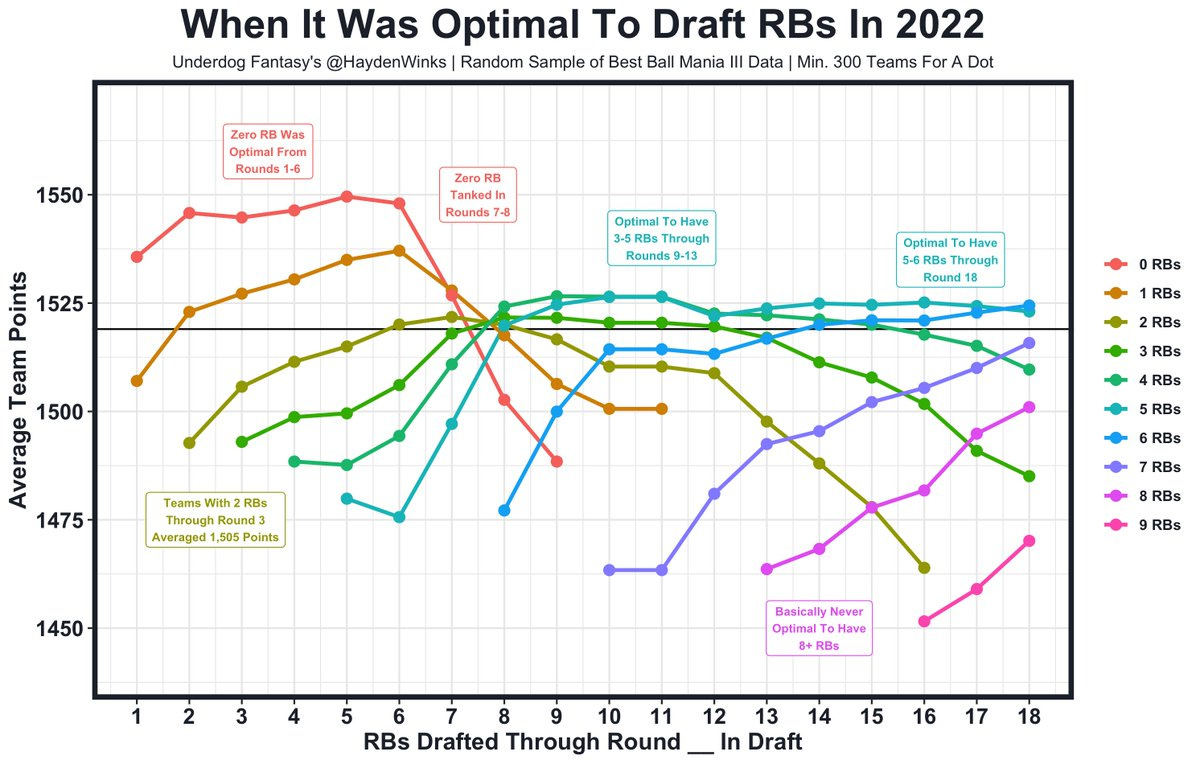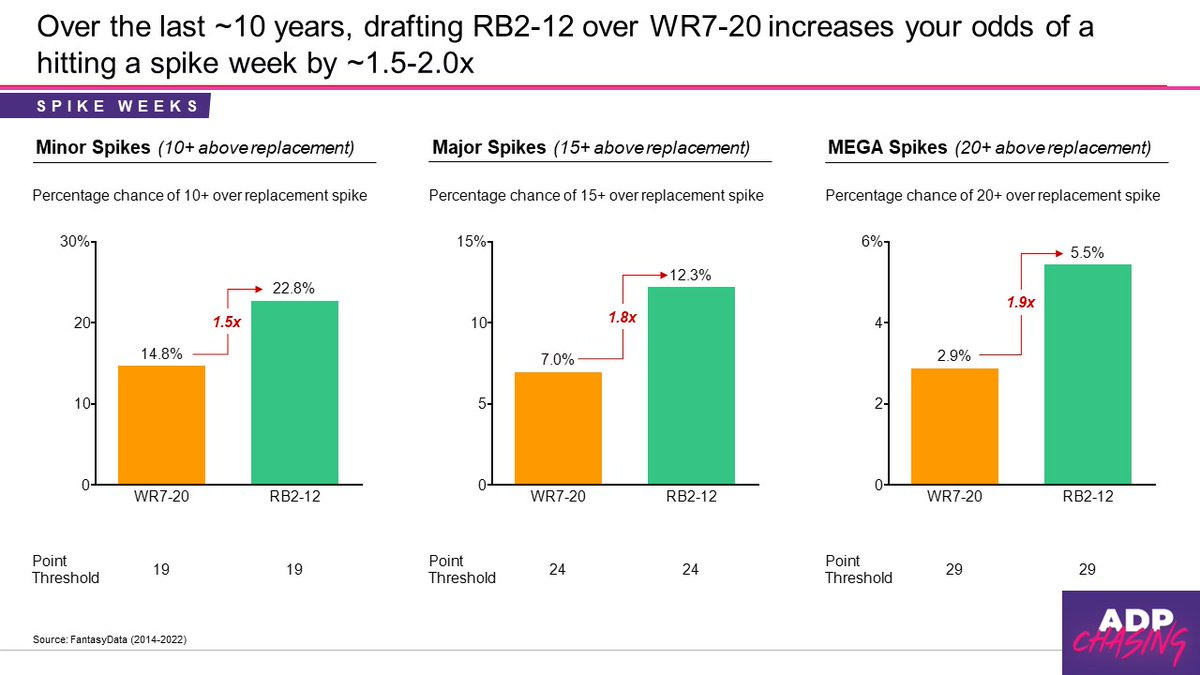Best Ball Ranks (Pt. 1) and Thoughts on the Wide Receiver Economy
The WR Drafters are Testing the Fence
I will be releasing v1.0 of my best ball rankings in two parts, with the second soon to follow. That’s because while I won’t be making annotations on each player in this version of the ranks I want to write a pre-amble to each part of the rankings that addresses some of the meta factors behind them.
Today I will provide my ranks from the 1.01 until the end of the “wide receiver window.” Shortly thereafter I will provide my ranks for the second half of the drafts, along with a commentary on how my approach changes at this hinge point of the board. Hope you enjoy!
Thus far I’ve drafted just under 100 best ball teams into either Best Ball Mania or one of the standalone tournaments. I can without question say this is the toughest year to do “rankings.”
That’s because in 2022, Zero-RB won the war. For several years, the democratic Zero-RB socialists have had better PR than the robust-RB brethren or the “draft the best players” Manchin-ites, but last year we also happened to have a substantial degree of success passing the Green New Deal (err, scoring fantasy points).
Chart below from Hayden Winks:
In response to the great Zero-RB victory of 2022, WRs are flying off the board at a record pace. Depending on your perspective, this either enhances the systemic scarcity of the receiver position demanding you to take more WRs earlier to stay ahead of the draft, OR leaves several RBs deeply underpriced, providing opportunities to gap the receiver loving hippies across the early rounds.
Zero-RB was incontrovertibly a winning strategy in the year of our Lord 2022, but that has not been the case in either 2021 or 2020 in half-PPR best ball; posting well below average advance rates in both. The same could be said for Robust-RB in all three years. Do the Manchin-ites have a point?
It’s hard to say.
Zero-RB and Half-PPR Best Ball
Despite what some well-crafted memes by ZRINO Sam Sherman will have you believe, the Zero-RB strategy has always had multiple planks of appeal. I outlined my take on the strategy both in relation to the initial sacred text by Shawn Siegele and to 2022 drafting environments last year in my debut column of The Hitchhiker’s Guide to RB. It relies on a mix of constant and evolving variables.
The increased injury risk of RBs is central to the thesis and unlikely to change. The relationship between risk of injury to highly-drafted RBs and the viability of late-drafted RBs is also a constant: when someone else’s Round 1 RB gets hurt, an angel loses its wings, and whomever is rostering their backup likely gets an RB2 for the following week.
As Sherman pointed out via meme, a central thesis of Zero-RB also was that WRs score more points: both among similarly drafted assets at the top of the draft board, and especially among flex players. This creates a scarcity effect on the position that demands you to build depth at WR in order to “win the flex.” While this is true in the full-PPR managed leagues zero-RB was created for, In half-PPR best ball, the flex is roughly equally likely to be won by a WR or a RB.
The more damning application of Zero-RB to half-PPR best ball is the relative utility of late-round RBs and WRs. As my Samaje Pe-Line loyalists know, you are far better served investing in backup RBs with end-of-bench spots in managed leagues because they have far more predictable use-cases than similarly priced WRs.
Is the starter hurt? Fire up the backup. Starter playing? Ride the pine.
It’s a much easier determination than playing pin the tail on the Marquez Valdes-Scantling spike week. The effect of this in managed leagues is that you are typically able to replicate the production of an every-week RB2 by churning spot starts from your bench; something we did successfully last year in the Hitchhiker’s guide column.
However, in best ball leagues, you are no longer disadvantaged by the unpredictability of late-round WR spike weeks, which vastly reduces the advantage late-round RBs vs. their WR counterparts, as pointed out by Sherman.
So where does all this leave us?
The three years of best-ball tournament data rejects that Zero-RB either can’t succeed or can’t fail in the format; at least in the economy of those draft years.
The more important question is how to navigate the current economy. If you are simply aiming to draft the RB or WR who is likely to score the most points at a given point in the draft, you will probably wind up clicking a lot of RBs.
However, the Zero-RBers are pushing back against the usefulness of this approach. Madison Parkhill, in his Substack “Reducing Uncertainty” (which you should all subscribe to) made a compelling case that the current draft market is actually efficient when you consider the systemic scarcity of the receiver position.
Parkhill’s case is largely alligned with my Zero-RB pitch based on the prioritization of earned volume vs. given volume: while there is a firm limit on the opportunity to draft weekly, high-level performers at receiver due to the correlation between their talent and production, that is less true at RB, which allows us to find consistently high-level performers later in drafts.
Therefore, when attempting to craft the best overall roster construction - rather than just the highest scoring player at each given pick - we should be prioritizing WR with our early selections to ensure we have enough access to earned volume upside.
Comparative Advantage Drafting
The question of how to approach the new wide receiver economy has dominated my thoughts this off-season, and I’ve chosen to embrace radical centrism.
While some components of the Zero-RB thesis apply to half-PPR best ball tournaments, others do not.
This transforms Zero-RB from a universally applicable draft strategy to increase both your ceiling and floor, to a viable, but high-variance strategy which is reliant on favourable conditions.
Because earned-volume scarcity remains constant in any format, there are diminishing returns to prioritizing RBs vis a vis WRs early in drafts.
Taking these components together, I view this year’s draft environment as a game of chicken.
How many RBs can I draft to secure the ceiling projection edge before the opportunity cost at WR becomes too large? (you still have to start 3 or 4 of them every week!)
At which portions of the draft do RBs have the greatest comparative advantage to WRs and vice versa?
There are countless possibilities for how the season could play out, but the twitter consensus take that R2-3 RBs (Taylor, Barkley, Chubb, Pollard, Henry, Stevenson, Jacobs, Hall) are strong bets to outscore the relative WRs in that range, and do so at an outsized margin compared to RBs drafted in the first round or the middle rounds seems to me well-founded.
Surely some of these RBs are bound to bust. There will be injuries, there will be reduced workloads, there will be good old fashioned bad variance. But this tier of RB is deep enough that I think the most likely outcome for this season is whichever drafters are substantially overweight on the best performing RBs of this group, while building the best structural teams around them, will advance a lot of teams to the playoff rounds. (As for what happens after that… that’s a different beast) For that reason, I will be light on true Zero-RB teams compared to previous years, but I will also be fairly light on R1 and mid-round RBs (on aggregate).
My best ball rankings are based less upon who I think is a better pick vs. each other at each individual spot, and more around how I am prioritizing each player in relation to the larger draft meta.
This is the year of comparative advantage drafting.
For example, I would wager Dameon Pierce outscores the WRs at his ADP in half PPR points per game a majority of the time. I would say the same regarding Cam Akers. But in a comparative advantage mindset, that is not sufficient. We need to be target the RBs who have the best chance to create meaningful separation from the WRs at their respective ADPs and/or those who have the least fragility relative to their opportunity cost.
Because of the scarcity of WR in these rooms, every RB selection has both great power and great responsibility. I would guess that the effect of a major bust at RB will be outsized in 2023 drafts, and we should be wary of taking on fragile bets, especially those without the corresponding ceiling.
With that pre-amble out of the way, here is v1.0 of my Best Ball Rankings for Underdog:
Note:
These are tournament rankings, catered especially toward Best Ball Mania IV
The bracketed number is my desired exposure relative to market average. (Because there are 12 teams in each draft, an average exposure = 8.3%, so 1X = 8.3%, 2X = 16.7%, 0.5X = 4.2%, X = 0% etc.)
In general, I will break ties within tiers based on roster construction first, correlation second, player preference third, and exposure management fourth. I avoid reaching outside of tiers for correlation, but it is occasionally necessary to keep up a reasonable construction. (See Michael Leone’s Best Ball Manifesto for construction tips)
These are envisioned as actionable ranks rather than my rankings in a vacuum: i.e. I am ranking these players based on the order I would *actually* draft them (subject to my target exposures). This means I am quite willing to punt certain fades far down my ranks, but not willing to rank targets egregiously ahead of ADP because you should not be taking players egregiously ahead of ADP. (If I have a player’s target exposure at 2X or higher, I would probably draft them a lot higher than I have them ranked if I needed to)
When I have a lower-ADP player ranked above a higher ADP player, I draft the lower-ranked player first roughly proportionate to the amount necessary to hit my target exposures
I will update these ranks in relation to major news in the meantime, and do a full v2.0 ranks with some more player notes toward the end of July.
Best Ball Rankings (Part 1)
Keep reading with a 7-day free trial
Subscribe to Thinking About Thinking: A Fantasy Football Newsletter to keep reading this post and get 7 days of free access to the full post archives.






